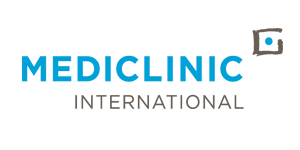- Customer Success Stories
- Mediclinic International

On the pulse of
analytic-supported
healthcare

At Mediclinic, using SAS-powered analytics is about more than improving the bottom-line.

Results
Predictions on clinical outcomes
Better allocation of resources
according to patient risk
Company achieved this using • SAS® Viya® • SAS® Visual Data Mining and Machine Learning • Open Strategy
In his 12 years at Mediclinic International, Analytics and Reporting Group General Manager Jannie van Schalkwyk has seen analytics come a long way, and it is this mainstreaming and growth that has kept him engaged and positive about the power of analytics for over a decade.
How can you put an ROI on a life?Jannie van Schalkwyk Analytics and Reporting Group General Manager Mediclinic International
Holistic view
For Van Schalkwyk – a mathematician and statistician and computer scientist by training – it is in the overlap between analytics and business that he sees the most potential. “I have a passion to build this bridge,” he says. “It led to me doing my MBA a few years ago. I wanted to give myself the tools to better understand the business side of things, to foster collaboration between analysts and the business. I know that if analytics is just a ‘back office space’, you're not going to achieve the strategic goals.”
Thankfully, the executives and upper management of Mediclinic agree. “We don't have to tell business what we do,” Van Schalkwyk says, “they come to us.”
Embedded in the culture
“Analytics in Mediclinic started off small,” he says, “but it has grown over time. It's an exciting environment, and critical to both the financial and operational sides of the business.”
Today, Mediclinic has an international footprint with operating divisions in Switzerland, Southern Africa (South Africa and Namibia), and the United Arab Emirates, and holds a 29.9% interest in Spire Healthcare a UK-based private healthcare group. And one of the enablers of the Group’s strategy and goals is that “we are an analytics-driven company,” Van Schalkwyk explains.
“The nature of our business is that we generate a lot of information across many different aspects of care delivery, and our job is to understand what to do with it. Analytical tools help us in two ways. Firstly, to handle the variety, volume and velocity of data, and secondly to enable people to do their work faster and more effectively,” he continues.
Industry challenges
Mediclinic – as a healthcare provider and a listed company – faces a number of significant challenges that are characterising healthcare around the world. “The first is affordability of care,” Van Schalkwyk says. “It is very expensive to keep up with the advances in healthcare while remaining affordable. It is a worldwide phenomenon. There are lots of new treatments and technologies coming through, and patients demand (and deserve) access to these.”
Just what the doctor ordered
“That was a big advantage of SAS at that point in time - powerful enough to address many types of business problems,” he says. And when the SAS platform began to open up – to new methods, tools, and open source integration – it really came into its own, he adds.
“I found that with the SAS® Viya® platform, opening up the environment to open source tools and allowing for flexibility of language and skills, our team is able to do what they need to using their preferred tools and techniques. This was a great move from SAS, and that is why we invested in that.”
“But you might ask, why not just go full open source then? Well there is significant benefit to the standardisation of having a single platform where all the languages and tools come together. This also enables robust governance and auditability too.”
Beyond ROI
Of course, Van Schalkwyk says, business wants to see the return on investment (ROI) on any investment, and the analytics tools are no exception. “It is difficult to quantify ROI directly from analytics, although there are a few examples I could point to. Rather I prefer to look at its effect on the bigger value chain in the business.”
“We value things like teamwork at Mediclinic. Analytics feeds into teamwork. It adds to our organisational capacity and knowledge. In our department, we take raw data and translate that into insight, and the organisation can start learning from that insight. We also provide the organisation with tools that assist them to manage their operations.”
So on the one side, he explains, you have more effective processes which leads to better healthcare and a good market reputation. On the other, it’s also aiding more revenue, and that's going to mean more profitability.
“But there is something greater to consider, and that is the work that we do here has a direct impact on the survival or not of a patient. We use analytics to do predictions on clinical outcomes, to improve clinical pathways, to better allocate resources according to patient risk. SAS is a tool that empowers us to achieve this.”
“How can you assess the ROI of someone's life? That's the value that I would brag about.”
Our team is now able to do what they need to using their preferred tools and techniques.
